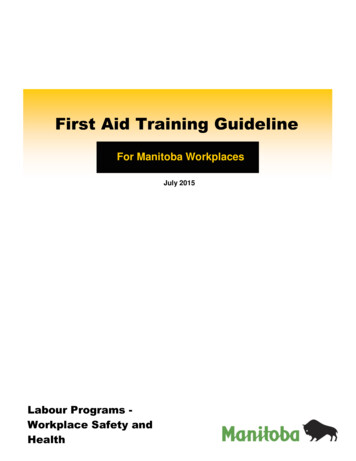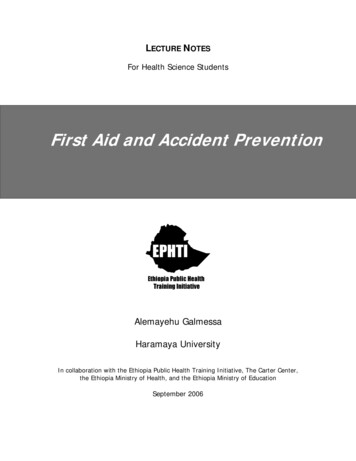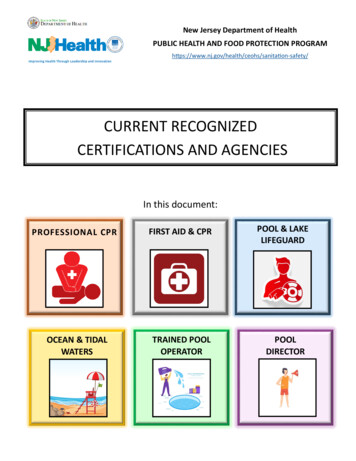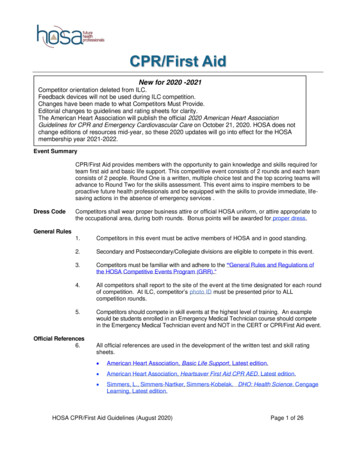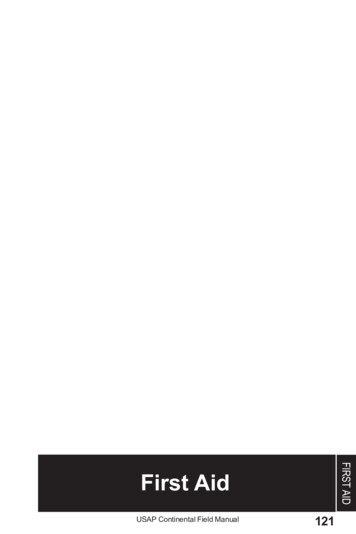
Transcription
FIRST AIDFirst AidUSAP Continental Field Manual121
Basic Field First Aid ManualThis First Aid Manual describes some of the medical issues thatmay be encountered in an Antarctic field environment. This is notan exhaustive manual, but it will serve as a guide to those with limited medical background to help treat their companions. It shouldbe read in advance to help field team members recognize dangerous situations and help prevent injuries from occurring or becomingmore serious if they do occur.Antarctica is an inherently risky environment. Participants are oftendehydrated, mildly hypothermic, and sleep deprived. This can leadto an increase in accidents. It is essential that all team membersslow down, assess each task, and ensure the safety of the team.There are a variety of medical kits provided to teams depending ontheir activities, locations and needs. Team members should familiarize themselves with the contents of the the kit – before there is aneed to use it.HygieneOccasionally, people deploying to the deep field use the remote environment as an excuse to abstain from normal hygiene and sanitation. Extreme cold temperatures, lack of running water, and communal living make bathing, brushing teeth, and basic hygiene a chore.People must continue with a normal hygiene routine to avoid painfuland distracting issues that can occur in the absence of cleanliness,such as dental abscesses, gum pain, yeast infections, skin rashes,cracked skin, and trench foot.Wet-wipe and sponge baths are the norm. If wet wipes are preferred, personnel should bring enough for the anticipated time inthe field. Blanket partitions can be set up in large tents to create asemi-private space.FIRST AIDSprains and StrainsSprains and strains are the most common injuries in Antarctica.People must work carefully, thoughtfully, and deliberately to avoidthem. A sprain is an injury that involves tearing the ligaments thathelp keep joints intact. A strain involves overstretching a muscle.122USAP Continental Field Manual
Sprain and Strain Signs and SymptomsSprains and strains will manifest as pain at the site of the injury thatmay radiate outward. There will also be swelling and discoloration.Sprain and Strain TreatmentR Rest: Stop activity, make the patient comfortable, and set upshelter if necessary.I Ice: Cool down the affected area with water, snow, or ice for approximately 15 minutes. Don’t apply directly to the skin.C Compression: Wrap the affected area with an elastic bandage.E Elevation: Keep the affected limb raised to reduce swelling.Immobilize the JointFingers: Wrap them together.Wrist: Splint it if it is very swollen. If not swollen, or when the swelling subsides, bandage it from the palm to the elbow, including thethumb, with an elastic (ACE ) bandage. The patient should exercise the fingers, elbow and shoulder regularly.Knee: If it is very swollen, suspect a more serious injury. Withthe knee as straight as possible, wrap a thick layer of cotton woolaround the leg from mid-calf to mid-thigh and then apply an elasticbandage.Ankle: The foot must be kept at a right angle to the leg. Remove theboot. Using an elastic or tape bandage, bandage the foot from thetoes to just below the knee, keeping the foot up and covering all theskin. If the ankle is very swollen, especially on both sides, then amore severe injury should be suspected.Caution: Do not wrap bandages too tightly. Toes must remain warmand pink and have feeling.Bleeding and WoundsUSAP Continental Field Manual123FIRST AIDTreatment of External BleedingCheck the wound for foreign bodies, while being careful not to disturb any clots. If no foreign object is seen, apply direct pressure overthe wound with your fingers, palm, or whatever is necessary to coverthe wound, attempting to hold the edges of the wound together. Thismay be maintained by using Steri-strips or tape. Place a steriledressing pad over the wound, ensuring that the edges of the pad
extend well beyond the edges of the wound. Secure the pad with abandage.If bleeding is not controlled by the first dressing, then apply anotherdressing on top. Do not remove the previous dressing before applying the second, as this might destroy any clotting that has occurred.If the bleeding is from a limb and no fracture is suspected, the limbshould be elevated and supported.Foreign BodiesIf foreign bodies are present on the surface of the wound, carefullyremove them if they can be wiped off easily with a swab. If a largeforeign body is embedded, never attempt to remove it. It may beplugging the wound and restricting bleeding. Moreover, the surrounding tissues may be injured further if it is pulled out. If the embedded foreign object is too tall to cover, place rolled up dressingson either side of it. Secure the dressing(s) with a bandage.Treatment of WoundsClean all wounds with Betadine antiseptic liquid and apply a steriledressing. Small wounds can be taped together with Steri-strips orBand-Aids . Dry the edges of the wound, squeeze together, andstick the Band-Aid across the wound. Several may be needed tohold the cut together. Apply a sterile dressing over the top and bandage it. If a serious infection is indicated, advise medical personnelas soon as possible. Infection may be present if there is increasingpain, swelling, redness, and/or fever.FIRST AIDCarbon Monoxide PoisoningCarbon monoxide (CO) can be produced by burning anything containing carbon, including fuel in open flames, gas cookers, or engines. CO poisons by attaching itself to the hemoglobin in the blood.It does so about 200 times more readily than oxygen, easily displacing inhaled oxygen. When enough hemoglobin is compromised, theremainder cannot carry sufficient oxygen to the rest of the body.Oxygen starvation of the brain will cause permanent damage, evenif the patient is revived. Furthermore, the toxicity of CO increaseswith altitude.Carbon Monoxide Signs and SymptomsOften there are none. However, the following may occur:124USAP Continental Field Manual
Slight headache Shortness of breath Panting Confusion Nausea Chest pains Dimming of vision Feelings of exhilaration or lassitude Dizziness Excessive yawning Ringing in the earsIn latter stages, the patient’s skin color becomes pink to cherry red,though the red and yellow polar tents will make it difficult to noticeany skin color change. Unconsciousness and death is often rapid.Carbon Monoxide TreatmentIf carbon monoxide poisoning is suspected: Immediately move the patient to fresh air or to an uncontaminated tent. Provide the patient with 100% oxygen, if available. Contact Medical and describe the incident and symptoms. Keep the patient quiet and resting for at least eight hours.Early exertion may cause cardiac arrest. If breathing stops, commence cardio-pulmonary resuscitation (CPR).Carbon Monoxide Poisoning PreventionField parties must utilize the issued carbon monoxide detector.Team members must ensure there is adequate ventilation at alltimes in all buildings, shelters, and vehicles. Tents or other sheltersmust be thoroughly ventilated during cooking and before personnelbed down each night.HypothermiaUSAP Continental Field Manual125FIRST AIDHypothermia occurs when a person’s core temperature is reducedto a level where normal brain and body functions are impaired. Hypothermia progressively affects a person’s judgment, perception,and coordination.Wind greatly increases the chilling effect of cold. The faster the air
moves, the more heat it can drag away. This is wind chill. The cooling effects of air can be seen by referring to the wind chill chart inthe reference section.Wet clothes, from sweating, marine dampness, or precipitation alsocause chilling. Finally, fatigue reduces a person’s ability to protecthimself or herself, and it diminishes the physiological capacity tothermoregulate and maintain a proper core temperature.Hypothermia PreventionHypothermia is prevented by wearing the proper clothing and bysupporting and regulating the body’s heat production. Proper nutrition and hydration help prevent hypothermia, and adequate restis critical. Exhaustion promotes the onset of hypothermia and precedes its development in almost all cases. The tendency to “presson” has led to many unnecessary deaths.A layered clothing system should be employed, where layers can beadded or removed as needed. Field team members should not allowthemselves to get either cold or hot and sweaty.FIRST AIDHypothermia Signs and SymptomsHypothermia manifests in three stages: Mild: This stage includes shivering and personalitychanges. A person may become withdrawn, apathetic, orirritable. There is a loss of fine motor control. Field partymembers should always be on the alert for a team member displaying the “umbles”: stumbles, mumbles, fumbles,and grumbles. Moderate: At this stage, hypothermia progresses to violentshivering, altered mental states, and disorientation. Moderate hypothermia also manifests as a loss of gross motorskills, such as balance and coordination (ataxia). Severe: In this stage, shivering stops and the level ofresponsiveness drops. A person becomes unresponsiveand may appear dead, with very slow and weak pulse andrespiration rates. An individual will appear cold and blue,and he or she may have associated frostbite. Cardiac arrest is possible.Hypothermia TreatmentThe essential and immediate treatment for hypothermia is to preventfurther heat loss by insulating the body. If any member of a fieldparty shows signs of developing hypothermia, the individual must be126USAP Continental Field Manual
moved into shelter immediately.Mild hypothermia may be turned around quickly. A person with thiscondition should be: Helped into additional clothing layers and fed quick-energy carbohydrates and warm, sweet drinks, such as hotchocolate or warm electrolyte beverages. Encouraged to run in place or perform another exercise. Provided dry clothes, if necessary, and external heatsources, such as hot pads or water bottles filled with warmfluid.If moderate to severe hypothermia is suspected, contact Medicalimmediately. The patient should be placed in a hypothermia wrap,which is a bundle made of sleeping bags and reflective sheeting,with warm heat sources on the patient’s neck, armpits and groin.(Body-to-body rewarming in a sleeping bag is of limited usefulnessand may result in two cold people.)FrostbiteFrostbite is freezing of body tissue. Areas most at risk are the extremities and exposed skin (ears, nose, face). Factors that lead tofrostbite are: Previous frostbite injury Cold temperatures and wind High altitude Overexertion (fatigue and dehydration) Touching metal or super-cooled liquid fuel Poor circulation Constrictive clothing or footwear Underlying medical problems HypothermiaUSAP Continental Field Manual127FIRST AIDFrostbite PreventionFrostbite is almost always avoidable. A buddy system shouldbe established to observe any whitening on the face or ears of acompanion. If any whitening or tingling of the face, ears, feet, orhands occurs, these areas should be warmed immediately. Socksand bootsshould fit snugly, with no points of tightness. Liner glovesshould be worn so that skin is never exposed when performing workthat can’t be done in heavy gloves.
Strenuous exercise should be avoided in extreme cold, particularlyat high altitudes. Very cold air brought too rapidly into the lungs willchill the body’s core. Perspiration under conditions of extreme coldshould be avoided. Perspiration evaporates, chilling the body.Plenty of food should be consumed to produce maximum output ofbody heat. Food items in cold weather should tend toward quickenergy first, such as fats and carbohydrates, and then proteins. Inaddition, personnel should drink two to three liters of water per dayto stay hydrated.Avoid the following, which can promote the occurrence of frostbite: Smoking Alcohol Excessive coffee and tea drinking Excessive fatigue Improper or inadequate eating habits Unnecessary medication Exposure to fuel, especially on bare skinMild Frostbite Signs and Symptoms (pre-thaw)There is an uncomfortable sensation of coldness, followed by numbness and skin anesthesia. In superficial frostbite (frost nip), the skinturns red, then pale or waxy-white. In partial thickness frostbite, theskin becomes cold and frozen on the surface, but remains soft andpliable when gently pressed.FIRST AIDFull-Thickness Frostbite Signs and Symptoms (pre-thaw)The skin is waxy-white. Toes and fingers become solid (like a pieceof chicken taken from the freezer). They feel wooden, and the skincannot be rolled over the bone.Full-Thickness Frostbite Signs and Symptoms (post-thaw)The entire hand or foot swells, which limits the mobility of the injured toes or fingers. Blue, violet, or grey (the worst) discolorationappears. After two days, the patient suffers severe throbbing andshooting pains. Huge blisters form, usually between the third andseventh day. These usually dry up, blacken, and slough off, leavingan exceptionally sensitive thin, red layer of new skin.Frostbite TreatmentFrostbite should not be rubbed, as this will cause additional tissuedamage from the ice crystals within. Treatment in the field for any-128USAP Continental Field Manual
thing beyond superficial frostbite is full of challenges and additionalrisk for the patient. Prevention is paramount!Superficial Frostbite Treatment (Frost Nip)Superficial frostbite can be treated effectively in the field. If noticedpromptly, it can usually be treated by the firm, steady (no rubbing)pressure of a warm hand or by blowing onto it with warm breath. Superficially frostbitten feet are best treated by removing the patient’sfootwear the moment there is any suspicion of danger and rewarming the feet immediately. After warming is complete, the affectedfeet should be covered with dry socks. If footwear is replaced, itshould be done loosely to ensure adequate circulation and warmthis maintained.Partial-Thickness Frostbite TreatmentPartial-thickness frostbite of a small body area should be reheatedin water that is between 42 C and 43 C (107 F and 109 F). Waterat higher temperatures can burn the skin. The injury should thenbe treated to prevent infection, bandaged for protection, and keptwarm. Refreezing must be prevented, as this will cause major additional damage. Medical personnel should be consulted if necessary.USAP Continental Field Manual129FIRST AIDFull-Thickness Frostbite TreatmentBecause of limited resources in the field, full-thickness frostbite is amajor medical emergency. Medical personnel should be contactedimmediately for consultation and to discuss evacuation plans. Rewarming should not be attempted in the field if there is any possibility that the affected part may become refrozen. In such cases, theaffected part must be kept frozen until it can be re-warmed rapidlyunder controlled conditions.If rewarming is recommended, remove jewelry (especially rings) ifpossible. Immerse the injured part in 42 C to 43 C (107 F to 109 F)water, continually adding water and stirring it to maintain a constanttemperature, until the digital tips (ends of fingers or toes) turn pinkor burgundy red. This takes approximately 20 minutes to one hour.When adding water, take care that the water is not more than 44 Cand is not poured directly over the injured body part.Significant pain, swelling, and blistering will develop after re-warming. Do not puncture the blisters, and do not allow the injury to refreeze.Protect the thawed injury with sterile, soft, fluffy dressings. Separatetoes and fingers with cotton wool. Wrap the whole part lightly with
gauze bandages. Do not change dressings unless they get dirty,and never rub the skin. Keep the patient and the injured body partwarm. Pain medication will be needed, and medical personnel willadvise on specific type and dose. In addition: Elevate the injured limb(s) Commence antibiotic treatment, per medical personnelinstruction Keep the patient absolutely still, lying down Evacuate to a medical facility as quickly as possibleImmersion FootImmersion foot, or trench foot, is a medical condition caused by prolonged exposure to cold, damp, and unsanitary conditions.FIRST AIDImmersion Foot PreventionFeet should be kept warm and dry by wearing protective footwear,and they should be checked frequently during wet and cold conditions. Footwear should not be constrictive, and it should be cleanedand dried at every opportunity. In the field, extra pairs of dry socksshould be carried next to the abdomen under the shirt. Wet sockscan be dried by placing them next to the abdomen, either inside oroutside the shirt.If feet get wet, they should be dried as soon as possible. They canbe warmed by the hands. Foot powder should be applied and drysocks put on. If it is necessary to wear wet socks and footwear forany length of time, then the feet should be exercised at regular intervals by wriggling the toes and bending the ankles.Immersion Foot Signs and SymptomsThe area becomes cold, swollen, waxy-white and mottled with burgundy-to-blue splotches. The skin becomes numb, deep sensationis lost, and movement of the affected area becomes difficult.If allowed to continue untreated, the area becomes red, hot, andswollen, and blisters appear. The victim experiences constant throbbing and a burning sensation. Skin numbness is aggravated byheatand relieved by cold.Immersion Foot TreatmentRemove wet footwear. Gently and rapidly rewarm the affectedfoot by immersing it in warm water (about 40 C). Once the foot is130USAP Continental Field Manual
warmed, dry it completely and elevate it in a warm room. Swaddle itwith clean bandages or cloth to keep it warm and clean.The injury must not be rubbed or massaged. Blisters should be keptclean and dry. Do not apply ointments. Two 200 mg ibuprofen tabletsevery four hours may be administered for pain, if required. Evacuatethe victim to a medical facility.Altitude SicknessAltitude sickness (also called acute mountain sickness, or AMS)is caused by the body not adapting to the reduced availability ofoxygen at altitude (as elevation increases, barometric pressure decreases). The higher the altitude, the more common AMS becomes.Symptoms may range from minor lethargy to a coma, and deathmay result, so any symptom must be treated with caution. Anyonecan be affected by altitude sickness, regardless of age, fitness level,or previous experience at altitude. Healthy individuals may experience symptoms as low as 2,500 meters (8,200 feet). Beyond 3,000meters (9,840 feet), 75% of people will experience some level ofAMS. The symptoms usually start 12 to 24 hours after arrival at altitude and begin to decrease in severity around the third day. MildAMS does not interfere with normal activity, but anyone experiencing symptoms should communicate this to others so the person canbe monitored.Many work sites in Antarctica, such as Amundsen-Scott South PoleStation and Mount Erebus, are at high altitude. The Fang Glacier acclimatization camp on Mount Erebus is at 2,900 meters (9,500 feet),with South Pole Station only slightly lower. Since the polar atmospheric effect raises the pressure altitude 10% to 15% above actualelevation, both of those locations will feel like 3,200 meters (10,500feet) or more, increasing the risk of AMS.AMS risk is also increased by rapid ascent to altitude (e.g., by aircraft), so team members must factor sufficient time for acclimatization into their schedule when flying to a high-altitude site. Minimumwork should be planned for the first few days.USAP Continental Field Manual131FIRST AIDAltitude Sickness PreventionIt is common to fly to altitude in Antarctica, thus increasing the riskof altitude sickness. For those traveling to Mount Erebus (3,794 meters, 12,450 feet), spending at least two nights acclimatizing on theFang Glacier seems to reduce altitude-related problems. Unfortu-
FIRST AIDnately, it is usually not possible to have acclimatization camps forpolar plateau work. For those traveling to the plateau, bring altitudemedicine (if medical personnel advise doing so), and pack Gamowbags and oxygen, if possible. In addition, taking these steps canreduce the incidence of AMS: Do not overexert upon arrival at altitude (take it easy forthe first three days) Avoid depressant drugs like sleeping pills and narcotics Avoid alcohol and tobacco Get plenty of sleep Stay hydrated Consider taking Diamox (discuss this with Medical beforehand)Above all, adjust expectations of how much work can be completedin the first few days at altitude. Team members should check in oneach other constantly and let each other know how they are doing.Stoically withholding information could be dangerous and is poorexpedition behavior. If a team member is still not feeling better after72 hours, follow up with Medical.Altitude Sickness Signs and SymptomsMild/Moderate AMS - Most people arriving at altitude will see theirbreathing rate increase immediately. Other mild symptoms includeheadache, nausea, fatigue, and lack of appetite. The average timeto recover from mild AMS is approximately three days. Full acclimatization may take two months. Yet, a small number of individualsare unable to acclimatize at all. Prior experience at altitude doesnot exclude a person from contracting altitude-related illnesses, nordoes a high level of fitness.Moderate AMS - Moderate AMS will manifest as a more severeheadache (which is not relieved by medication), increased nauseaand vomiting, increased lethargy, loss of appetite, light-headedness,disturbed sleep, shortness of breath (even while resting), and decreased coordination. Normal activity becomes difficult. Thoughthese symptoms may be due to other causes, it is wise to assumethey are due to AMS until proven otherwise. The only treatmentsfor moderate AMS are advanced medication or immediate descentto a lower altitude, with the latter being the preferable option. Without treatment, moderate AMS could become more severe.Severe AMS - Severe AMS may manifest as High Altitude Cerebral Edema (HACE) or High Altitude Pulmonary Edema (HAPE), or132USAP Continental Field Manual
both. Signs and symptoms of severe HACE are loss of muscularcoordination (ataxia), decreased mental status (confusion, coma),severe headache, weakness, and vomiting. It appears that personswho have had HACE in the past are more susceptible to developingit again.HACE is a potentially fatal condition. Altered consciousness andloss of coordination are the base markers for HACE. The individualwill be unable to take care of basic needs (eating and dressing).Within a day of losing coordination, HACE victims slip into a coma.Without proper medical care, death will result.HAPE, however, is the most common altitude-related cause ofdeath. Earliest signs are decreased exercise performance and increased recovery time. Specific HAPE signs and symptoms are drycough, shortness of breath at rest, a gurgling/crackling noise heardin chest during breathing, and pale or blue color to skin and nail beds(cyanosis). In the late stages, a wet, productive cough will be present. As with HACE, people who have had HAPE in the past have ahigh likelihood of developing it again. Both the Lower Hut on MountErebus and South Pole Station have seen more than a few cases ofHAPE over the decades.USAP Continental Field Manual133FIRST AIDAltitude Sickness TreatmentAcetazolamide (Diamox ) is used as a preventive measure beforegoing to altitude. It is a diuretic and respiratory stimulant that accelerates the body’s acclimatization. With the consent of medicalpersonnel, team members should begin taking it several days beforeascent.Dexamethasone (Decadron ) is another preventive pharmaceuticalthat reduces swelling of the brain. It also used as a treatment. In thelatter case, medical personnel can authorize its administration.Mild to moderate AMS requires rest, medication for headaches andnausea, hydration, proper nutrition, and supplemental oxygen, ifavailable. If AMS occurs, the best treatment is rapid descent. Contact medical personnel to discuss the severity of the case and recommendations for evacuation. Supplemental oxygen is helpful, inaddition to using Diamox and/or Decadron .A Gamow bag is a portable hyperbaric chamber that simulates rapiddescent. It has saved hundreds of lives at altitude worldwide sinceits introduction in 1990. If descent isn’t possible because of flightdelays or because team members cannot take the victim down
themselves, a Gamow bag is the best asset to have. The elevationat which teams will be working will determine if the members needto be trained in Gamow bag operation and issued one for the field.HACE TreatmentEarly, simple tests (similar to roadside sobriety tests) can be conducted to look for the loss of coordination that is the hallmark ofHACE. Individuals may be asked to stand with eyes closed and armsextended to the side, then asked to touch their nose. Also with eyesclosed, they may be asked to walk forward, heel to toe. Be sure thatsomeone is ready to catch them if they stumble. However, differentiating between moderate AMS and the initial stages of HACE maybe difficult. Assume the worst and treat for HACE.Severe AMS/HACE requires an urgent call to Medical. Evacuationis likely. If immediate descent is not possible, the patient should beplaced in a Gamow bag. Provide the patient with oxygen. Medicalpersonnel may also prescribe Diamox and Decadron .HAPE Treatment-URGENTIf HAPE is suspected, contact Medical immediately to request anevacuation. Immediately descend 600 to 1,200 meters (2,000 to4,000 feet), if possible. Use a Gamow bag while waiting for evacuation, and provide the patient with oxygen. Nifedipine may be helpful.Medical can authorize administration of this medication.Eye InjuriesFIRST AIDTent EyeAntarctica’s extreme low humidity may cause the film of tears protecting the eye to dry up, making the cornea susceptible to damagefrom stove fumes in the tent. The condition can be treated by applying Chlorsig ointment to the eye when it occurs and/or beforegoing to sleep.Snow BlindnessSnow blindness is caused by ultraviolet (UV) light burning the eyes.The danger of snow blindness is greatest not on clear, bright daysbut on dull, cloudy (whiteout) days, when crystalline snow mist ispresent. There is no warning that damage has been done until thesymptoms begin to appear two to twelve hours after exposure.134USAP Continental Field Manual
Snow Blindness Signs and SymptomsSnow blindness manifests as intensely painful, red, watering eyesthat are sensitive to light. The victim will also feel as though there isgrit in the eyes.Snow Blindness TreatmentA single episode of snow blindness may last up to five days, evenwhile being treated. The eyes should be rested for at least 24 hours.That means closing them and covering them with a non-fluffy pad. Ifthe temperature is above freezing, a cold compress may be placedover the affected eyes to relieve pain. Medical should be contactedfor treatment recommendations and possible medications. Medicalpersonnel may recommend providing the victim two tablets of ibuprofen (400 mg) every four hours, as required, or putting Chlorsigointment on the eyes every three hours.Snow Blindness PreventionThis condition must be avoided, as it is a crippling injury that mayseriously delay a field party. Team members should wear dark, UVprotective glasses or goggles with the appropriate lenses (not yellow) at all times when in the field, especially on overcast days.Skin InjuriesSunburn and WindburnDirect exposure to the sun, especially when it is very windy or thebody is wet with sweat, can result in a sunburn and chaffed skin.Because the Antarctic air is cleaner and thinner, there is greaterultra-violet penetration, so sunburn can occur even on overcastdays. If sunburn occurs, apply aloe vera gel to the burn and providethe victim 400 mg of ibuprofen every four hours, as necessary, torelieve pain.USAP Continental Field Manual135FIRST AIDSunburn and Windburn PreventionPrevent sunburn by applying sunscreen ChapStick to the lips andregular sunscreen to other areas of exposed skin. Covering the facewith a balaclava will prevent both sunburn and windburn to this frequently exposed area.
Dental HealthOral HygieneOral hygiene can be inconvenient in the field, but it is just as important as bodily hygiene. Failure to maintain good oral hygiene may result in increased tooth decay (especially around the edges of fillings)and gingivitis. Ideally, teeth must be brushed after every meal, withsnow if no water is available. Use toothpicks or waxed dental floss toclean gaps between the teeth that are hard to clean with the brush.Controlled MedicationsIssue of Restricted DrugsThe McMurdo clinic issues a field medication kit containing overthe-counter, prescription, and controlled medications (restricteddrugs) to each designated field party medical lead. The field medication kit is the responsibility of this person. The medical lead (or anyUSAP participant) must contact a station doctor for consultation andauthorization before administering any medication. Always checkfor any known allergies before administering drugs.FIRST AIDChain of CustodyMcMurdo clinic personnel will fill out a controlled drug Chain of Custody form and provide it to the field medical lead. The lead mustaccount for all controlled substances when the kit is checked out,weekly, and when the kit is returned. If the lead departs before theend of the season, he or she must complete a new Chain of Custodyform and count the medications before transferring the kit to anotherperson. At the end of the season, the medical kit must be returnedto the clinic.136USAP Continental Field Manual
USAP Continental Field Manual
FIRST AID Basic Field First Aid Manual This First Aid Manual describes some of the medical issues that may be encountered in an Antarctic field environment. This is not an exhaustive manual, but it will serve as a guide to those with lim-ited med


